Environmental Balancing Act
Most Americans (54%) express at least some confidence in Bush’s ability to balance environmental and economic demands, with 21% expressing “a lot” of confidence in the president in this area. This is comparable to how the public viewed Clinton’s environmental leadership. In 1997, 61% had some confidence in Clinton’s ability to balance environmental protection with economic needs, with 22% saying they had a good deal of confidence in him.
 Partisanship is evident here as well. Fully 86% of conservative Republicans and 73% of their more moderate counterparts are confident that Bush’s policies will strike the right balance. This compares to just 46% and 26% of moderate and liberal Democrats, respectively. In 1997, Democrats were nearly twice as likely as Republicans to be confident in Clinton’s environmental leadership.
Partisanship is evident here as well. Fully 86% of conservative Republicans and 73% of their more moderate counterparts are confident that Bush’s policies will strike the right balance. This compares to just 46% and 26% of moderate and liberal Democrats, respectively. In 1997, Democrats were nearly twice as likely as Republicans to be confident in Clinton’s environmental leadership.
As was the case in 1997, environmental groups have considerable credibility with the public, especially when compared to business and labor groups. While 27% have a lot of confidence in the ability of environmental groups to balance the economy and environment, just 12% have a high level of trust in business groups, and labor unions fare no better. Just over 20% have a lot of confidence in the ability of Democrats in Congress to balance environmental and economic needs — the same proportion as have faith in Bush. Republicans in Congress fare worse, with only 14% expressing a lot of confidence.
 Interestingly, those who voice the most concern about environmental degradation are also largely unaware of Bush’s policy decisions in this area. Less than a quarter of those who worry a lot about the environment know that Bush decided not to place limits on carbon dioxide emissions, even fewer know that the Bush administration has withdrawn the U.S. from the Kyoto agreement and more than half have heard nothing at all about the debate over arsenic in drinking water.
Interestingly, those who voice the most concern about environmental degradation are also largely unaware of Bush’s policy decisions in this area. Less than a quarter of those who worry a lot about the environment know that Bush decided not to place limits on carbon dioxide emissions, even fewer know that the Bush administration has withdrawn the U.S. from the Kyoto agreement and more than half have heard nothing at all about the debate over arsenic in drinking water.
As a result, although people who worry about the environment are more skeptical about Bush than those who do not share their concerns, the differences are not as pronounced as might be expected. Nearly half (44%) of respondents who say they worry a great deal about most environmental issues have at least some confidence in Bush’s ability to balance environmental and economic concerns, compared to 62% of those who are less worried about these problems.
Similarly, those most concerned about the environment are not much more pessimistic than others in their assessments of whether environmental progress is likely on Bush’s watch. Better than one-third (36%) of the environmentally concerned think Bush is likely to make real progress in protecting the environment, only slightly fewer than those who do not worry about the environment (41%).
Local Matters Most
As in the past, the public’s greatest environmental concerns are those closest to home, while global environmental problems remain a much smaller worry. And though most are open to efforts at global cooperation on environmental issues, they are unwilling to have the U.S. bear too much of the burden of efforts to solve international environmental problems like global warming.
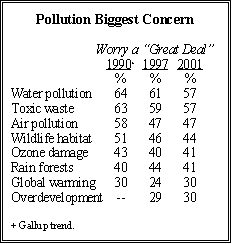 Pollution of rivers, lakes and reservoirs and the possible contamination of soil and water by toxic waste remain the most widespread environmental concerns in this country. However, the proportion of Americans who say they worry a great deal about these kinds of pollution, as well as air pollution, has dropped somewhat over the past decade. Whereas 64% of Americans worried a great deal about water pollution in a 1990 Gallup survey, 57% do so today, and the proportion worried about air pollution has dropped by an even larger margin. More than four-in-ten (44%) are very concerned about the loss of the natural habitat for wildlife, while only 30% worry as much about commercial development of open space.
Pollution of rivers, lakes and reservoirs and the possible contamination of soil and water by toxic waste remain the most widespread environmental concerns in this country. However, the proportion of Americans who say they worry a great deal about these kinds of pollution, as well as air pollution, has dropped somewhat over the past decade. Whereas 64% of Americans worried a great deal about water pollution in a 1990 Gallup survey, 57% do so today, and the proportion worried about air pollution has dropped by an even larger margin. More than four-in-ten (44%) are very concerned about the loss of the natural habitat for wildlife, while only 30% worry as much about commercial development of open space.
Global environmental issues rate as a lower priority for most Americans. Global warming, the loss of tropical rainforests and damage to the earth’s ozone layer are less of a concern relative to local pollution issues.
The public continues to be moderately supportive of U.S. participation in international efforts to solve global warming. By nearly two-to-one the public disapproves of Bush’s decision to withdraw U.S. support from the Kyoto agreement, and 58% think the U.S. should join other countries in setting standards to improve the global environment, instead of setting its standards independently.
But the public is more reluctant when it comes to certain steps aimed at reducing global warming. While a plurality of Americans (45%) are aware that the U.S. produces more carbon dioxide per capita than other countries, few are willing to have the U.S. take on any greater responsibility for the clean-up. Two-thirds say that every country, rich or poor, should make the same changes now in order to limit future global warming, regardless of how much pollution they generated. Just one-in-four thinks poorer countries should not have to bear as much of the burden because they did not cause as much pollution.
GOP Leaders’ Turnaround
Republican leaders in Congress are getting better ratings under a Bush administration than they did during most of Clinton’s presidency. Their current 30% disapproval rating is the lowest one GOP leaders have registered since December 1994, at the start of the so-called Republican revolution. Roughly a year ago, opinion was slightly more negative than positive — 38% approved and 43% disapproved.
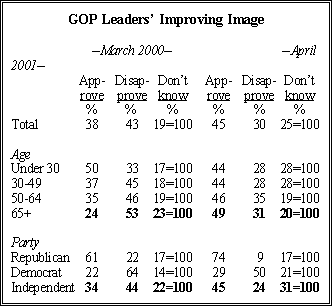 Since last year, the most dramatic shifts in opinion about GOP congressional leaders have come among senior citizens and political independents. In March 2000, those age 65 and older disapproved of the job Republican leaders in Congress were doing by a margin of 53%-24%. Today, seniors approve of the job they are doing — 49%-31%. Similarly, independents disapproved of GOP leaders last year by 44%-34%, now they approve (45%-24%). Catholics have also done an about-face on this issue, approving of Republican leaders now by a solid 45%-31% margin, compared to 34%-49% last year.
Since last year, the most dramatic shifts in opinion about GOP congressional leaders have come among senior citizens and political independents. In March 2000, those age 65 and older disapproved of the job Republican leaders in Congress were doing by a margin of 53%-24%. Today, seniors approve of the job they are doing — 49%-31%. Similarly, independents disapproved of GOP leaders last year by 44%-34%, now they approve (45%-24%). Catholics have also done an about-face on this issue, approving of Republican leaders now by a solid 45%-31% margin, compared to 34%-49% last year.
Despite the GOP leadership’s improved ratings, the public remains divided as to whether the party has become more compassionate and caring than it has been in the past. Just under half (47%) agree that the party has become more compassionate, while a similar proportion (46%) reject this notion. Republicans are much more likely than Democrats to agree that their party has mellowed — 73% vs. 30%, respectively. As might be expected, those who agree that Republicans have become more compassionate have a much more favorable view of GOP leaders in Congress than those who disagree.
Leadership Vacuum
At the same time, there are signs of a leadership vacuum within the Democratic Party. There is no public consensus as to who is the party’s leader, and fully 27% didn’t identify anyone as filling that role.
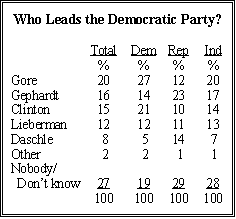 Democrats and Republicans differ in their views of who now leads the party. Gore and Clinton top the Democrats’ list, while Republicans regard Gephardt and, to a lesser extent, Daschle as the party’s leaders. Independents are fairly evenly split among their choices, although relatively few choose Daschle.
Democrats and Republicans differ in their views of who now leads the party. Gore and Clinton top the Democrats’ list, while Republicans regard Gephardt and, to a lesser extent, Daschle as the party’s leaders. Independents are fairly evenly split among their choices, although relatively few choose Daschle.
When asked about how leaders of the Democratic Party are responding to Bush’s policies and proposals, a plurality of Americans (45%) say they are speaking out about the right amount. Nearly one quarter (23%) say they are speaking out too little, and 15% say they’re speaking out too much. But there are important partisan differences on this issue, as Democrats are the most dissatisfied with their leadership’s response to Bush. More than one-third (36%) say their leaders are not speaking out enough, while 45% say they are speaking out about the right amount.
Public Less Tight-Fisted
While the public offers broad support for Bush’s tax-cut plan, it is showing little appetite for fiscal austerity. Better than three-quarters of Americans (76%) favor increasing the education budget — one of the president’s key budget priorities — and nearly as many want to boost spending on health care (71%) and Medicare (70%).
Of the 15 budget items tested in the survey, the public supports increased spending for 10 and favors maintaining current levels of funding for the other five. In no case does a plurality want to decrease spending on a program. The budget surplus has apparently caused Americans to be less tight-fisted in considering spending for specific federal programs. Support for higher funding for some key programs — notably Medicare and military defense — is up sharply from four years ago.
In May 1997, Americans were divided over Medicare — 44% favored increased spending, while the same number wanted to maintain current funding levels and 8% wanted to reduce spending. Today, while seven-in-ten favor an increase, 26% support the status quo and just 2% favor a reduction.
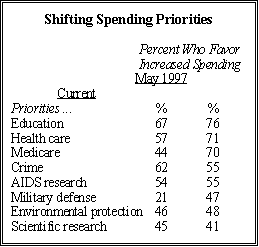 The shift in opinion on defense spending has been even more dramatic. Four years ago, more Americans said military spending should be decreased rather than increased (30% to 21%). Today, a plurality (47%) favors increased spending, while 40% support keeping funding at current levels and just 11% back a cut. Overall, the number favoring a bigger budget for the Pentagon has more than doubled — from 21% to 47%.
The shift in opinion on defense spending has been even more dramatic. Four years ago, more Americans said military spending should be decreased rather than increased (30% to 21%). Today, a plurality (47%) favors increased spending, while 40% support keeping funding at current levels and just 11% back a cut. Overall, the number favoring a bigger budget for the Pentagon has more than doubled — from 21% to 47%.
Support has grown more modestly for increased funding for health care (from 57% to 71%) and education (from 67% to 76%). Attitudes on funding for other programs, such as general scientific research and AIDS research, have not changed significantly, while support for increased anti-crime funding has actually dropped (from 62% to 55%), perhaps in response to lower crime rates.
More Support for Pentagon
Not surprisingly, Republicans and Democrats have significant disagreements over how to allocate federal dollars. Nonetheless, solid majorities of both parties, as well as independents, support higher budgets in several key areas: education, Medicare, health care and veterans’ benefits.
 Beyond that, major differences emerge. The top budget priorities for Republicans are education and defense — 68% of Republicans favor increasing funding for both programs. Just 40% of Democrats and the same proportion of independents back more money for the Pentagon. Narrow pluralities of both groups (47% of Democrats, 44% of independents) want to keep military spending at current levels.
Beyond that, major differences emerge. The top budget priorities for Republicans are education and defense — 68% of Republicans favor increasing funding for both programs. Just 40% of Democrats and the same proportion of independents back more money for the Pentagon. Narrow pluralities of both groups (47% of Democrats, 44% of independents) want to keep military spending at current levels.
Still, support for higher defense spending has increased across the political spectrum since 1997. Backing among Republicans for higher Pentagon funding has more than doubled (from 33% to 68%), while Democratic support has tripled (from 13% to 40%). And one-in-five independents favored more money for defense in 1997, compared to 40% today.
Leading Democratic priorities are health care, education and Medicare — in each case, more Democrats than Republicans favor higher spending. But the biggest partisan gaps, aside from defense, are over funding for AIDS research and environmental programs. Nearly two-thirds of Democrats (65%) and 61% of independents favor boosting the budget for AIDS research, compared to 36% of Republicans. More than half of Democrats and independents (56% and 54%, respectively) back higher funding for the environment, while just 29% of Republicans agree.
Powell’s Pitch Unpopular
The survey shows that Secretary of State Colin Powell has minimal public support for his effort to raise the budget for U.S. embassies and other State Department programs. As has traditionally been the case, support for funding overseas programs — either for the State Department or foreign aid — lags well behind domestic programs.
More than twice as many Americans support decreasing State’s budget as favor increasing it (26% to 11%). A majority (55%) wants to maintain funding at current levels. Similarly, there is significantly more support for cutting foreign aid rather than increasing it (31% to 17%), while a plurality favors keeping the aid budget at its current level.
Execute McVeigh, Not on TV
Three-quarters of Americans believe that convicted Oklahoma City bomber Timothy McVeigh should be put to death. That is higher than the 66% who supported the death penalty in principle in a Center survey conducted last month (see “Faith-Based Funding Backed,” April 10).
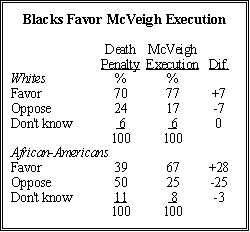 The enormity of McVeigh’s crime, as well as his unrepentant attitude, may have caused some people to rethink their opposition to the death penalty. In the earlier survey, African-Americans opposed the death penalty, 50%-39%. But fully two-thirds believe that penalty is appropriate for McVeigh — a swing of 28 points.
The enormity of McVeigh’s crime, as well as his unrepentant attitude, may have caused some people to rethink their opposition to the death penalty. In the earlier survey, African-Americans opposed the death penalty, 50%-39%. But fully two-thirds believe that penalty is appropriate for McVeigh — a swing of 28 points.
Similarly, only a narrow majority of Democrats (54%) offered generic support for the death penalty, but seven-in-ten back that penalty for McVeigh. Among Americans with annual household incomes above $75,000 there was a 14-point shift — 65% supported the death penalty, while 79% favor McVeigh’s execution.
But only about a quarter of the public (24%) favors televising McVeigh’s execution, while 73% say it should not be broadcast. More than twice as many white men as white women (32% vs. 15%) believe that McVeigh’s execution should be broadcast. Younger Americans are also more likely to support broadcasting the execution; three-in-ten of those under age 50 say McVeigh’s death should be broadcast, compared to 14% of those over 50.
While the public has shown little awareness of some recent events, most people are closely tracking developments in McVeigh’s case. Even about two-thirds of those under age 30 (66%), who generally don’t follow the news as closely as older Americans, are aware that the victims’ families will be able to watch McVeigh’s execution.
No Panic Over Food Safety
Americans are both attentive to news about dangers to the food supply, and cautious about food safety issues. However, the recent spate of news stories about foot-and-mouth disease and other food-related problems does not seem to have increased American concerns about food safety. More than half of Americans (51%) say their concern about the safety of the food they eat has neither increased nor decreased over the past year.
 Most Americans have been following news about the problems Europe has faced with respect to livestock diseases and the possibility of the contamination of the meat supply. In a Center survey conducted in mid-March, 55% of Americans said they followed news about the outbreak of foot-and-mouth disease among livestock in Europe, with 22% following the story very closely. Today, fully 94% say they have heard about the problems with the meat supply in Europe, and three-quarters (76%) say they worry that this could happen in this country as well.
Most Americans have been following news about the problems Europe has faced with respect to livestock diseases and the possibility of the contamination of the meat supply. In a Center survey conducted in mid-March, 55% of Americans said they followed news about the outbreak of foot-and-mouth disease among livestock in Europe, with 22% following the story very closely. Today, fully 94% say they have heard about the problems with the meat supply in Europe, and three-quarters (76%) say they worry that this could happen in this country as well.
Concerns about food safety run high, but no more so than before these recent events. Three-in-four (74%) say it is necessary to take precautions in the home against food poisoning, while just 22% believe government regulations on food provide adequate protection. More than four-in-ten (42%) say they are very
concerned about the safety of the food they eat, with another 27% somewhat concerned. But on both of these questions, surveys conducted in the 1990s found virtually identical levels of concern.
Similarly, while 36% think the food supply in this country is less safe than it was 10 years ago, and 38% say they are more worried than they were a year ago that the food they eat may be contaminated, these concerns are no greater than they were four years ago.
Women, especially older women, are more concerned about the safety of the food supply than men. Overall, 45% of women say they are very concerned about the safety of the food they eat, compared to just 37% of men. Over half of women of retirement age express this high level of concern.
Blacks also express particularly high levels of concern about food safety. More than seven-in-ten (71%) black respondents say they are very concerned about the safety of the food they eat, and more than half feel that the food supply is less safe than it was ten years ago (53%) and are personally more worried about food contamination than they were a year ago (52%). By comparison, just 38% of white respondents are concerned about the safety of the food they eat, 35% feel the food supply has become more dangerous, and 37% are more worried about food contamination than they were a year ago.
Concern about the food supply is also highest among the less educated — roughly half of respondents with no more than a high school degree are very concerned about the safety of the food they eat compared to just 30% of college graduates. Democrats also express higher levels of concern about food safety than Republicans, and are more likely to say that the food supply is becoming less safe than it was 10 years ago.
Release of Air Crew Tops News Interest Index
More than half of the public (55%) paid very close attention to the release of the U.S. air crew held by China, making it the month’s top story. Interest was fairly high among most major demographic groups, but there were partisan differences. Conservative Republicans paid much more attention to this story than did liberal Democrats (70% vs. 48%).
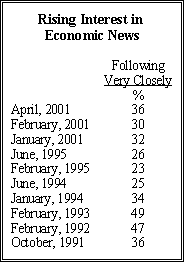
Interest in news about the U.S. economy ranked second, with more than one-third (36%) of Americans paying very close attention. Historically, interest in economic news has risen along with concerns over the nation’s financial health. Interest spiked in the early 1990s, then decreased during the economic recovery. Attention is up again this month, by six points over February.
About a quarter of the public (24%) paid very close attention to the congressional debate in Congress over Bush’s budget and tax cut plan. Republicans and Democrats paid the same level of attention to this story (27%), with independents slightly behind at 20%. The rioting in Cincinnati that followed the shooting of an unarmed black man by police was also followed very closely by about one quarter of the public (24%). Blacks paid significantly more attention to this story than did whites or Hispanics (45% vs. 21% and 20%, respectively).
About one-in-five Americans (22%) closely tracked continued violence in the Middle East. Floods in the Midwest were followed very closely by one-in-five Americans. At this stage, attention to the floods is far less than it was for the much more destructive flooding that hit the region eight years ago; 65% paid very close attention to Midwest flooding in August 1993.
The congressional debate over campaign finance reform garnered the very close attention of only about one-in-seven Americans (14%), while one-third of the public tuned out entirely. Since the controversy over Democratic fund-raising practices in 1996, news about money and politics has drawn relatively little interest, with barely one-in-five Americans ever paying very close attention to this story. Interest is fairly low among most demographic groups with one exception. By a three-to-one margin, Americans age 50 and over followed this story more compared to those under age 50 (24% vs. 8%).
The legalization of medically-assisted suicide in the Netherlands was followed very closely by only 7% of Americans, while better than half the public (56%) paid no attention to this story.


